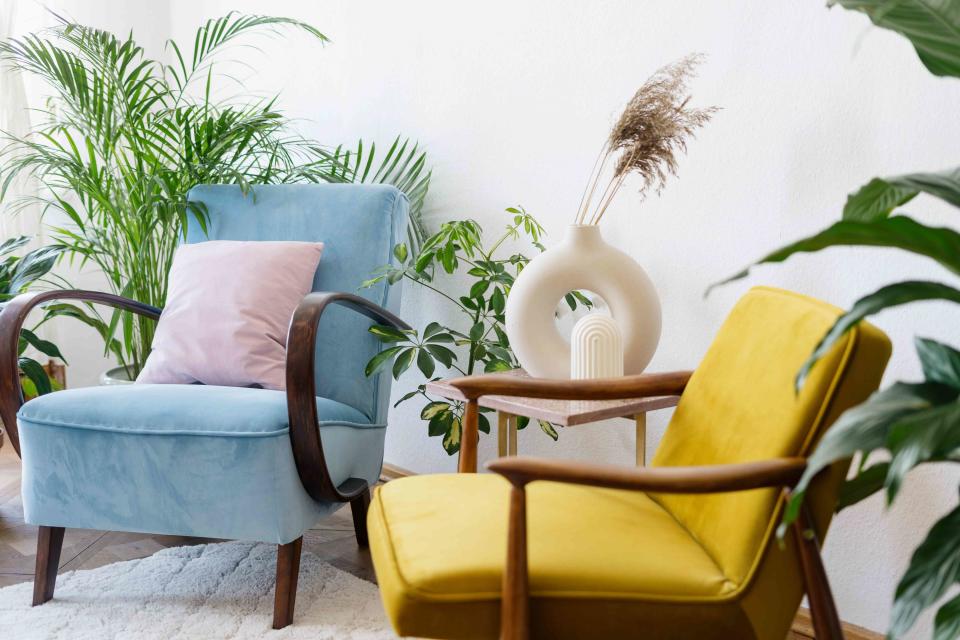How to Extend the Life of Your Furniture—and Mistakes to Avoid
A little basic care and some cleaning know-how can make your furniture look better longer.

Getty Images
Furniture is meant to be used—but, if we're too hard on it, it can get ruined pretty quickly. “Your furniture should last as long as you need it to with some consistent care and general maintenance,” says Jenon Bailie, merchandising and design director at Room & Board. “When you keep furniture clean and pay attention to how it’s wearing, you can be more proactive in making it last longer.” Bailie explains there are several ways to extend the life of your furniture, from habit shifts to maintenance tricks. Below Bailie and other pros share their tips for keeping furniture looking its best for a long time.
Start with good quality furniture
The first step to making your furniture last longer is to buy better furniture. High-quality furnishings can last decades (if not centuries!), whereas cheaply-made modern furniture can quickly break down. If you’re starting with something that is poorly made, it may not last long, even if you treat it with the utmost care.
Treat furniture with respect
As our lives have gotten more casual and furniture has gotten cheaper, many people have forgotten the basics of furniture care. Chief amongst them: Use your furniture as it is designed to be used: A couch should not be used as a kid's jungle gym, the wide arm of your easy chair is not a place to sit, and your dining chair is most definitely not to be used as a stepstool. When you move furniture, lift (don’t drag) the piece to wherever you are taking it.
Care for your cushions
You need to regularly flip, rotate, and fluff your cushions, says Bailie, noting, “This will ensure the cushions wear more evenly and maintain their fluffiness longer.” Sarah Rinehart Fleischer, an interior designer based in Brooklyn, points out that you can also wear out a cushion by always sitting in the same spot, so switch up your Netflix viewing angle.
Vacuum your upholstered furniture
Your vacuum is not just for floors! “Removing things like pet hair or dust with a vacuum’s upholstery attachment or a handheld vacuum will prevent the fabric from breaking down faster,” says Bailie. Don’t forget to remove the loose cushions and vacuum beneath them, to get the crumbs and debris that gather out of sight.
Don’t let spills sit
In an ideal world food would never get anywhere near your upholstery, but if you do spill, always attend to it immediately, says Fleischer. “Blot up as much of the stain as possible with a clean, dry cloth–and don’t rub,” adds Bailie. For spot cleaning, Room & Board recommends Folex Instant Carpet Spot Remover or Crypton’s Purple or Gold Upholstery Stain Remover. When in doubt, do nothing and call a professional, advises Fleischer.
Stay out of the sun
To minimize fading, avoid placing upholstered pieces in direct sunlight, advises Bailie. This might mean rearranging your room, installing additional window treatments, or putting solar film on a skylight.
Protect your wood surfaces
Placemats, coasters, and table runners might feel a little old-fashioned to some people, but they help you avoid damaging the surfaces of tables with hot or damp items like a drinking glass. In other rooms of the house, avoid placing things like jewelry directly on your bureau or nightstand which can easily scratch the surface; if you keep a glass of water on your bedside table, don’t forget a coaster.
Be wary of wood cleaners
When it comes to wood maintenance, your best bet is to follow the advice of the maker. Bailie and the team at Room & Board say to avoid furniture polish, as it can accumulate over time and leave a residue.
Learn to love patina
Shiny, new things are well and good, but there’s nothing like an object that has grown beautiful with age and use. In the future when you shop for furniture, look for natural materials like solid wood, stone, wool, and cotton. Unlike their synthetic counterparts, these materials have a better chance to age gracefully over time.
Invest in maintenance
When a piece starts to really show its age, consider bringing it to a pro for a refresh. Refinishing and reupholstering are notoriously expensive, but if you have a high-quality piece, the repairs will buy you many more years of use. Plus, repair keeps beloved pieces in your family and out of the landfill.
For more Real Simple news, make sure to sign up for our newsletter!
Read the original article on Real Simple.

